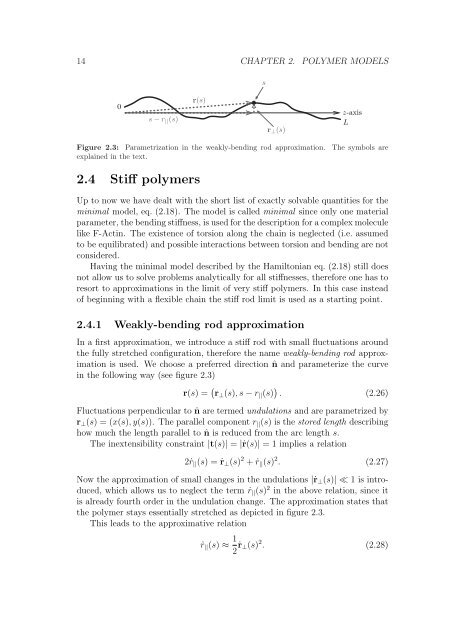Polymers in Confined Geometry.pdf
Polymers in Confined Geometry.pdf
Polymers in Confined Geometry.pdf
Create successful ePaper yourself
Turn your PDF publications into a flip-book with our unique Google optimized e-Paper software.
14 CHAPTER 2. POLYMER MODELS<br />
0<br />
s − r ||(s)<br />
r(s)<br />
s<br />
r⊥(s)<br />
z-axis<br />
L<br />
Figure 2.3: Parametrization <strong>in</strong> the weakly-bend<strong>in</strong>g rod approximation. The symbols are<br />
expla<strong>in</strong>ed <strong>in</strong> the text.<br />
2.4 Stiff polymers<br />
Up to now we have dealt with the short list of exactly solvable quantities for the<br />
m<strong>in</strong>imal model, eq. (2.18). The model is called m<strong>in</strong>imal s<strong>in</strong>ce only one material<br />
parameter, the bend<strong>in</strong>g stiffness, is used for the description for a complex molecule<br />
like F-Act<strong>in</strong>. The existence of torsion along the cha<strong>in</strong> is neglected (i.e. assumed<br />
to be equilibrated) and possible <strong>in</strong>teractions between torsion and bend<strong>in</strong>g are not<br />
considered.<br />
Hav<strong>in</strong>g the m<strong>in</strong>imal model described by the Hamiltonian eq. (2.18) still does<br />
not allow us to solve problems analytically for all stiffnesses, therefore one has to<br />
resort to approximations <strong>in</strong> the limit of very stiff polymers. In this case <strong>in</strong>stead<br />
of beg<strong>in</strong>n<strong>in</strong>g with a flexible cha<strong>in</strong> the stiff rod limit is used as a start<strong>in</strong>g po<strong>in</strong>t.<br />
2.4.1 Weakly-bend<strong>in</strong>g rod approximation<br />
In a first approximation, we <strong>in</strong>troduce a stiff rod with small fluctuations around<br />
the fully stretched configuration, therefore the name weakly-bend<strong>in</strong>g rod approximation<br />
is used. We choose a preferred direction ˆn and parameterize the curve<br />
<strong>in</strong> the follow<strong>in</strong>g way (see figure 2.3)<br />
r(s) = r⊥(s), s − r||(s) . (2.26)<br />
Fluctuations perpendicular to ˆn are termed undulations and are parametrized by<br />
r⊥(s) = (x(s), y(s)). The parallel component r||(s) is the stored length describ<strong>in</strong>g<br />
how much the length parallel to ˆn is reduced from the arc length s.<br />
The <strong>in</strong>extensibility constra<strong>in</strong>t |t(s)| = |˙r(s)| = 1 implies a relation<br />
2 ˙r||(s) = ˙r⊥(s) 2 + ˙r||(s) 2 . (2.27)<br />
Now the approximation of small changes <strong>in</strong> the undulations |˙r⊥(s)| ≪ 1 is <strong>in</strong>troduced,<br />
which allows us to neglect the term ˙r||(s) 2 <strong>in</strong> the above relation, s<strong>in</strong>ce it<br />
is already fourth order <strong>in</strong> the undulation change. The approximation states that<br />
the polymer stays essentially stretched as depicted <strong>in</strong> figure 2.3.<br />
This leads to the approximative relation<br />
˙r||(s) ≈ 1<br />
2 ˙r⊥(s) 2 . (2.28)













